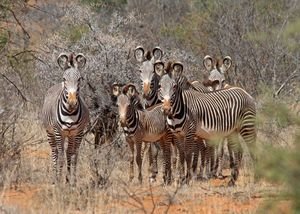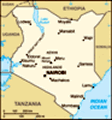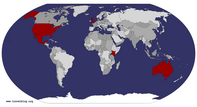Advertisement
Published: March 16th 2008

 Grevy's Zebra Family Portrait
Grevy's Zebra Family Portrait
A herd of Grevy's Zebras keeping a watchful eye on me while I wait patiently for starlings.The vast majority of the last week has been spent trapping starlings for the Brain Hormone Project. We're almost two weeks into the first of three three-week phases, and I've already killed a morally reprehensible number of birds. Sure it's in the name of science (and it is a novel study, the first of its kind), and I'll keep using that justification to keep myself from feeling too horrible about it, but the fact of the matter is that there's really little I can do to keep from being at ethical odds with myself. At least we anesthetize them first . . .
My daily routine for the past two weeks: wake up early, set up traps, catch birds, kill birds, repeat. As before, lots of waiting beneath a tree, reading and watching Africa pass by. It can dull, but I wouldn't call it boring - days in the field are often punctuated with little flurries of excitement here or there. Last Saturday, for instance, I was treated to both a family of warthogs (who kept a dubious eye on me as they approached) and an Aardwolf that sprinted across the glade after being spooked from its den by Wilson.

 Strange Mantid
Strange Mantid
Pretty cool mantis of some sort that I found crawling on me while trapping one morning at the research center.Then, a couple days later, I was surprised by a small herd of dik-dik that came scampering out of the bush as the Sosians hooted and barked behind them. While I never saw the wild dogs, it was exciting to know they were so close by. That same morning, I was treated to an impressive mantis of some sort (that I initially felt crawling on my leg). This is unrelated, but worth mentioning: that same afternoon, after cleaning up our respective sites, Wilson, Godfrey, and I shot the breeze for a while with one another. I don't recall how, but the topic of marijuana came up and led to a lengthy discussion on drug use in Kenya. Apparently there's not much of it outside the slums of major cities such as Nairobi, since it sounds like Kenyan society frowns upon all drugs greatly, and will even turn in friends or family smoking
bangi or
ganja to the appropriate authorities. Wilson made it sound as if Kenyan society has a genuine "reefer madness" outlook on the usage of marijuana, and that abusers turn into maniacal deviants capable of any atrocity. I found the conversation to be both surprising and amusing.

 Me and my Mantis
Me and my Mantis
It's hard to see, but it's crawling along the top of my hat.Two days later I was presented with an opportunity the likes of which I had previously only dreamed: to catch a dik-dik. As an individual ate the pawpaw beneath one of my traps, I excitedly pulled the string. This turned out to be a great underestimation of the dik-dik's fleeing capabilities, however, as I ended up chasing my trap all throughout the bush. Eventually the trap got stuck on an acacia, and I was able to carefully lift it while trying to get a hold of the tiny, panting antelope underneath. This is when I discovered the dik-dik's greatest defense mechanism: as soon as I had two hands on it, it shrieked something ferocious and I immediately let go in surprise (and fear that I was somehow killing it). It then scampered off into the bush, leaving me dik-dikless. Damn it. I'm still angry with myself for missing out on a fantastic photo op with a dik-dik.
A rather major change of pace in our field routine occurred last week when we were forced to use a different car as a result of a bent cross-bar and driveshaft in Bloodzilla. How this happened, I haven't a clue, but the

 Godfrey in a tree
Godfrey in a tree
Godfrey climbing down from an acacia with a bagful of baby starlings to be processed. I heard baby starlings pining for food while playing frisbee the other day, and noticed an active nest. This is an incredibly unusual find since Superb Starlings are supposed to wait for the long rains to breed. Perhaps this particular pair was confused by a very short bout of rains a few weeks ago.undercarriage started making a racket one day and Oreste, the mechanic, suggested we ground it until he could fix it. That was Saturday, so it's now been almost a week. In the meantime, we've been using one of Dan Rubenstein's (Dustin's dad's) Suzukis, of which he as two. The first morning we accidentally took the wrong one, an event that caused a bit too much of a ruckus all things considered. The difference between the two Suzukis is that one is large enough to carry our traps in the back (along with the three of us and all our other field equipment), while the other one is like Bloodzilla
sans the roof rack (and therefore too small to transport the traps). Otherwise they're quite similar decrepit POS's good for little other than a very bumpy mode of transportation (which, in reality, as all I really
need). Unfortunately, we're to drive the latter for the indefinite period it takes to fix Bloodzilla, making it very difficult to move traps and change sites. We can only hope our car is ready sooner than later . . .
The few hours of the day not spent in the field have also been

 Newbie Superb
Newbie Superb
One of the nestling Superb Starlings Godfrey removed from the nest to band and bleed.rewarding during the last week. The evening following sundowners with wild dogs, we researchers went to Siva and Corinna's for homemade pizza, a most welcome deviation from the all-to-predictable meat-and-grease Mpala dinners. It was great company, too: Sarah, Kayna, Rosie, and Rosie's boyfriend Simon formed the posse. I don't talk much in this crowd, but rather do quite a bit of listening. Kayna and myself are the only two without a graduate degree of some sort, but Kayna has spent two and a half years in Kenya, leaving me with little to add to conversations that primarily revolved around esoteric research, Africa, and esoteric African research. But it was pleasant to listen - there's a lot to be learned from these folks, especially the likes of Rosie and Simon, both of whom have led illustrious careers as wildlife biologists. Simon is currently the director of the Wildlife Conservation Society's (WCS) Asian Elephant Conservation Program and has no end of exciting anecdotes to tell from all his work and time spent studying the large mammals of Southeast Asia. He and Rosie make a good couple - both world-class biologists at the frontier of their fields. Still, while I envy them for

 Francis & Camera Traps
Francis & Camera Traps
Francis, a field tech working for Tim (the director's husband), taking the film out of camera traps. These traps catch images of anything that walks by, be it a person, a dik-dik, or a leopard.their intellectual prowess in these respective fields, I can't help but feel intimidated to the point of having second thoughts about a life in academia. It just seems like the vast majority of a life spent in academia is so esoteric and microfocused, and I think of myself more as a generalist. While I thoroughly enjoy learning about the various detailed minutia, I'd rather be specialized in the bigger picture of why and how the natural world works.
One of the most interesting things I learned from Simon was the origin of the "white elephant" part of the "white elephant gift exchange:" apparently, whenever a white elephant is born to an elephant owner or trainer in Thailand, that elephant is automatically and immediately property of the king of Thailand, for possession of white elephants indicates that the monarch is ruling with justice in a country of peace and prosperity. The person to whom the white elephant was initially born, however, still has the responsibility of raising and feeding the rare pachyderm, despite the fact that it's under the king's ownership. This is how the term "white elephant" has come to describe a supposedly valuable item whose cost, especially in

 Unwelcome Pawpaw Consumer
Unwelcome Pawpaw Consumer
In order to discourage unwelcome pawpaw thieves such as this Striped Ground Squirrel, I often catch them and then let them go after a good scolding.terms of upkeep, exceeds its usefulness. This was then applied to the gift exchange wherein participants contribute a gift that is useless to them, such as a gag gift, and walk away with another item. All the while, if someone decides that someone else has a gift that they actually think is worth something, they have the ability to steal it. It's a bit of a stretch, but I certainly see the connection.
There have also been a couple new arrivals to Mpala in the past few days. Jake Goheen, who recently finished a stint as an assistant professor at UC-Davis and got a job as a professor at UBC, is an animal ecologist with a broader scope of interest than most academians (a novel concept I definitely like): his research focuses on community dynamics and structure, animal-plant interactions, and macroecology. Very cool guy, quite chill with a good sense of humor yet incredibly smart. He's also a huge PJ (that would stand for Pearl Jam, geez) fan and a musician himself, and used to be the bassist for a band that opened for one of my favorites, Umphrey's McGee. The second newcomer is Christa Anderson, a Yale grad

 Mantis sp.
Mantis sp.
A very tiny, very cool species of mantis. I assume it's just a recently hatched juvenile and not an adult of some sort of miniature species, but I really have no idea.student who was initially in Nairobi working with some sort of UN environmental program until they told her to pack up and leave for fear of what peril the post-election upheaval might bring. She left to visit her boyfriend in India for a few weeks, then returned to Africa to visit friends and try to find work in Tanzania for a week, then finally found herself in Nairobi again. Corinna somehow got word of this lost Yale grad student looking for work, and took her on. Though roundabout, not a bad way to find yourself at Mpala.
Tonight proved to be one of the best highlights of the past week: instead of a regular dinner at the dining hall, there was a celebratory dinner at the staff village in honor of Siva and Corinna's recent wedding. I showed up a bit late, as I was sharing a beer with Jake and Sarah on Jake's veranda, and unfortunately missed a bout of singing by the kids of the village. By the time we did arrive, all the children were lined up at the food table, waiting for their meal. This is custom, to let the kids line up first, from

 Snared!
Snared!
Godfrey and Wilson demonstrating how a snare (that Wilson found near an old boma) works.youngest to oldest. And my goodness . . . there were
so many kids - at least a child for every adult in the village, it's truly remarkable. Apparently, due to the school on Mpala that provides free education to the staff's children, relatives often leave their kids here (but that's a whole 'nother story).
Once the kids went through, we researchers were next. We helped ourselves to some sort of cabbage salad, ugali (a bland corn-made mealy thing that resembles mashed potatoes in poor light), lamb, actual mashed potatoes, and a soda (all non-beer carbonated beverages are called sodas here - I picked a ginger beer). Then we found ourselves a patch of dirt to our liking and stuffed ourselves full of food. Without any napkins, we were quite a messy bunch. I ended up using my Carhartt's as a napkin, smearing my greasy maw on my knees and hands on my thighs. I jokingly said anybody could do the same, an offer that was surprisingly readily accepted! Greasy and beyond dirty, those pants are definitely getting a wash tomorrow . . .
Once all the staff had passed through the line and everyone had stuffed face,

 Grevy's in Transit
Grevy's in Transit
A herd of endangered Grevy's Zebras running past one of my field sites.one representative of each language in attendance gave a brief speech about Siva and Corinna. There were 5 or 6 speeches in total, and I'm not sure what all the languages were - in fact, some may have been represented twice - but there was at least Turkana, Kiswahili (my field tech, Wilson, did this one), English, and I think Masaai. Jake was made to give the English speech (which he wasn't prepared for), and gave a small yet rather hysterical anecdote about the first time Siva and Corinna met. Each speech was followed by a short round of polite applause.
After the speeches, the kids eagerly began singing again. They were quite a riot, stomping around and jumping, trying to imitate adults they had seen do the same. But they sounded amazing! I enjoyed one song, in particular, during which one girl would sing a phrase, and the whole group of kids (there honestly must have been at least 40-50) would repeat it in chorus, their little voices all trailing off into the night. I loved watching the little girls, who were all so happy and smiley, dancing with one another. The boys were fun to watch, too,
![[i]Acomys[/i] sp. [i]Acomys[/i] sp.](/pix/shim.gif)
![[i]Acomys[/i] sp. [i]Acomys[/i] sp.](/pix/shim.gif) [i]Acomys[/i] sp.
[i]Acomys[/i] sp.
A young species of [i]Acomys[/i], or spiny mouse (after consulting with Jake), that Wilson found and caught one afternoon.but they're usually just being little boys, running about craving attention from their peers. Eventually the men started to sing and dance, holding hands in a semi-circle with the occasional two or three men leaping into the middle and jumping up and down in rhythm with the song. It was cool to see, a sort of mix of traditional dance and improvisation (probably because the participants comprised multiple tribes), and it really made me want to see such a celebration in a more traditional setting - everybody was wearing street clothes, for the most part. Regardless, it was quite memorable and, though short-lived, enjoyed by all.
(I realize the pictures for this entry don't pertain much to the text, but they're all from the last week and make reading it a little more bearable, no?)
Advertisement
Tot: 0.19s; Tpl: 0.017s; cc: 14; qc: 98; dbt: 0.1002s; 1; m:domysql w:travelblog (10.17.0.13); sld: 1;
; mem: 1.4mb












